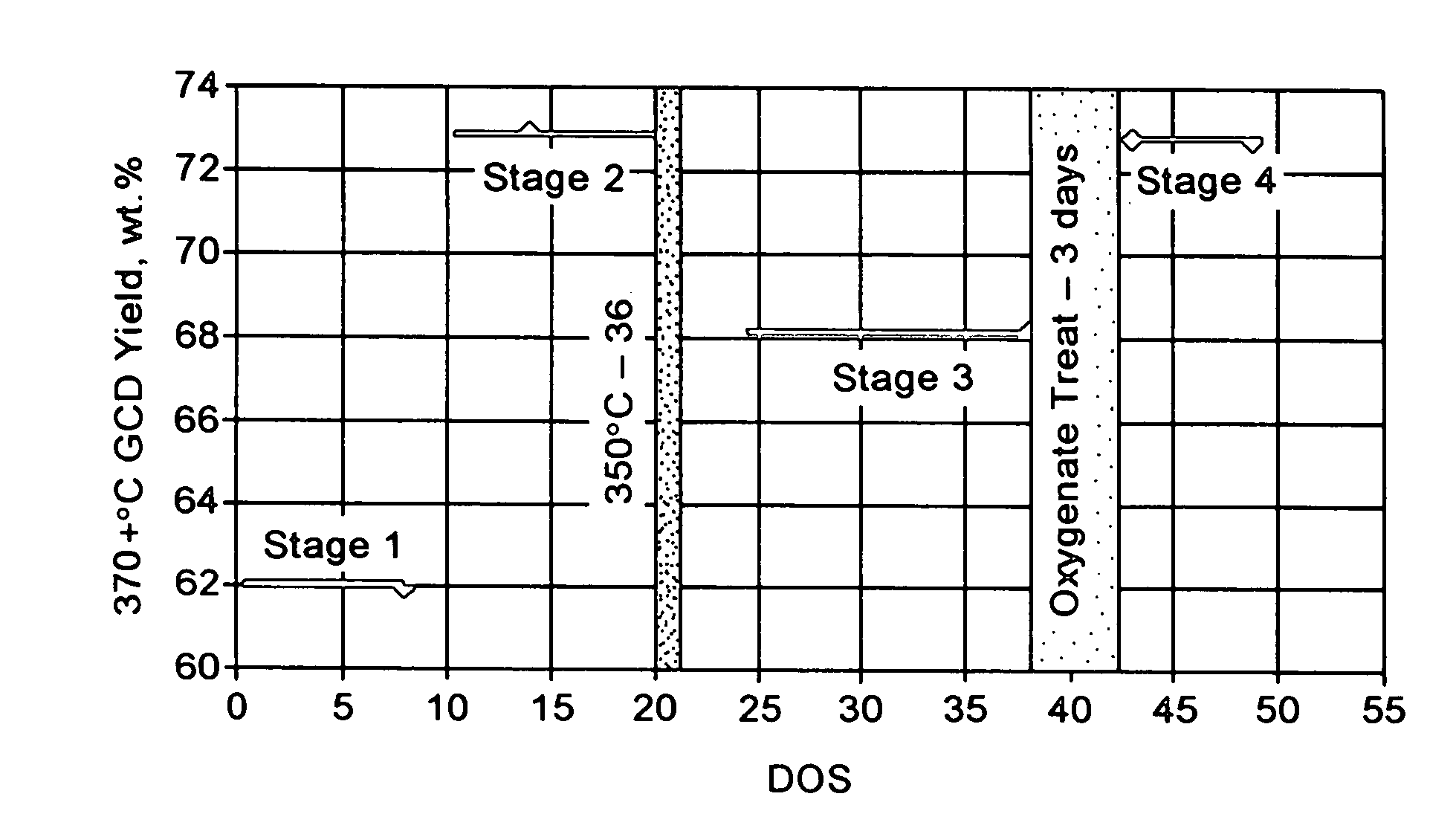Wax isomerate yield enhancement by oxygenate pretreatment of feed
a technology of oxygenate pretreatment and isomerate, which is applied in the direction of catalyst activation/preparation, petroleum chemical modification, physical/chemical process catalysts, etc., can solve the problems of limited ability of solvent dewaxing process to meet the increased demands placed on basestock quality, and achieve low temperature properties, improved isomerate yield, and viscosity
- Summary
- Abstract
- Description
- Claims
- Application Information
AI Technical Summary
Benefits of technology
Problems solved by technology
Method used
Image
Examples
example 1
[0065]This example demonstrates slack wax isomerates yield credit sustained by ZSM-48 catalyst selectivation using an oxygenate contained feedstock. The selectivation was carried out on a dried and reduced 0.6 wt. % Pt / ZSM-48 containing 35 wt. % alumina. The reference commercial ZSM-48 catalyst, 0.6 wt. % Pt / ZSM-48 / 35 wt. % alumina in metal oxide form, was dried at 180° C. under 200 psig flowing nitrogen pressure for 3 hours. The catalyst was then reduced at 260° C. under 200 psig flowing hydrogen for 4 hours to produce the dried and reduced catalyst (Cat-A). Temperature was then reduced to 150° C. and hydrotreated 150N slack wax (table 1) was cut into the unit.
[0066]ZSM-48 selectivation (Cat-B) was performed on a reduced catalyst (Cat-A) by processing an oxidized hydrotreated 150N slack wax containing between 1000 and 3000 ppm O, as measured by Neutron Activation Analysis. The selectivation was carried out at 332° C. under 1000 psig hydrogen pressure to produce Cat-B.
[0067]Four 316...
example 2
[0077]This example compares isomerate selectivity of ex-situ sulfided (Cat-C) and in-situ sulfided (Cat-D) ZSM-48 to that of the reduced catalyst (Cat-A). This example also demonstrates yield advantage by oxygenate treat of the ex-situ sulfided catalyst (Cat-E).
[0078]All catalysts were dried following the same procedure described in example 1 prior to any treatment.[0079](a) Cat-C was pre-sulfided ex-situ by using a 400 ppm H2S containing hydrogen treat gas. Cat-C was loaded, dried and wetted with 150N isomerate prior to processing hydrotreated 150N slack wax.[0080](b) Cat-D was dried under nitrogen, then sulfided in-situ in the reactor unit at 100 psig pressure and 200° C. for 48 hours using a spiked isomerate containing 400 ppm sulfur as dimethyl-disulfide.[0081](c) Cat-E was prepared in-situ in the reactor by treating the pre-sulfided (Cat-C) with a spiked isomerate containing 1000 ppm oxygen as n-decanol. The selectivation was carried out at 100 psig pressure, 200° C. for 48 hou...
example 3
[0084]This example shows the impact on selectivity by treatment with other polar compound such as nitrogen.
[0085]Cat-F was prepared in-situ by treating the pre-sulfided (Cat-C) with a spiked isomerate containing 20 ppm nitrogen as n-butylamine. The catalyst treatment with n-butylamine was carried out at 100 psig pressure, 200° C. for 48 hours.
[0086]
TABLE 4Cat-CCat-ECat-FEx-situCat-C withCat-C withTreatmentsulflded[O] treat[N] treatDays on Oil888Temperature (′ C)329329329370+° C. Yield (wt. %)61.973.752.7Selectivity Improvement (%)Base+20.5−16370+° C. Isomerate K.12.78512.85812.948Viscosity @40° C. (cSt)370+° C. Isomerate K.3.3713.4463.390Viscosity @100° C. (cSt)370+° C. Isomerate143153141Viscosity Index370+° C. Isomerate−19−17−17Pour Point (° C.)
[0087]Data reported in table 4 demonstrate that treating the ex-situ sulfided ZSM-48 catalyst with a nitrogen compound results in a selectivity debit. This demonstrates the uniqueness of oxygenate over other polar compounds such as nitrogen ...
PUM
| Property | Measurement | Unit |
|---|---|---|
| pressure | aaaaa | aaaaa |
| temperature | aaaaa | aaaaa |
| partial pressure | aaaaa | aaaaa |
Abstract
Description
Claims
Application Information
 Login to View More
Login to View More - R&D
- Intellectual Property
- Life Sciences
- Materials
- Tech Scout
- Unparalleled Data Quality
- Higher Quality Content
- 60% Fewer Hallucinations
Browse by: Latest US Patents, China's latest patents, Technical Efficacy Thesaurus, Application Domain, Technology Topic, Popular Technical Reports.
© 2025 PatSnap. All rights reserved.Legal|Privacy policy|Modern Slavery Act Transparency Statement|Sitemap|About US| Contact US: help@patsnap.com



